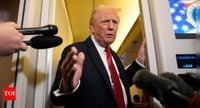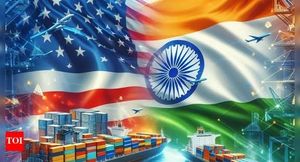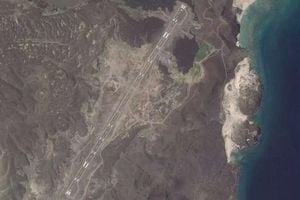In a recent interview with Fox News, former US President Donald Trump reignited debate over his role in the May 2025 India-Pakistan conflict, claiming that his administration’s threat of steep trade tariffs was pivotal in averting a nuclear war between the two South Asian rivals. Trump’s assertions, which have been met with skepticism and outright denial from Indian officials, underscore the enduring tensions and diplomatic complexities that surround the subcontinent’s security landscape.
Trump, never one to shy away from bold statements, told Fox News on October 20, 2025, “I’ve ended, you know, eight wars that we just mentioned. Five of them have been ended because of tariffs. The threat of tariffs, as an example, kept India and Pakistan—two nuclear nations—from going at it.” He elaborated further, stating, “They were going at it—seven planes were shot down. That’s a lot. And they were going at it. That could have been a nuclear war.” According to Trump, his administration’s warning to both New Delhi and Islamabad of a potential 200 percent tariff on trade was the decisive factor that forced both countries to step back from the brink. “I said to India and Pakistan pretty much the same thing: ‘Look, if you’re going to fight each other, I’m not going to do business with you. We’re going to put on a 200 percent tariff. It’ll make it impossible for you to do business,’” Trump asserted in the interview, as reported by The Economic Times and several international outlets.
Trump’s remarks refer to the dramatic escalation in hostilities that followed India’s Operation Sindoor in May 2025. In retaliation for the April 22 Pahalgam terror attack—which left 26 civilians dead—Indian forces launched a series of precision strikes on nine terrorist camps located in Pakistan and Pakistan-occupied Jammu and Kashmir (PoJK). The operation, which involved significant drone and missile exchanges, marked one of the most intense flare-ups between the two nuclear-armed neighbors in recent years. During these hostilities, both sides reported the loss of military aircraft, with Trump specifically citing that “seven planes were shot down.”
The situation, as described by Trump, teetered on the edge of catastrophe. “That could have been a nuclear war,” he said, emphasizing the gravity of the standoff and his belief that US economic leverage was instrumental in preventing further escalation. According to Trump, his intervention not only settled the immediate crisis but also drew praise from Pakistan’s Prime Minister Shehbaz Sharif. “Pakistan’s Prime Minister thanked me for my stance,” Trump claimed, though the specifics of this alleged praise have not been independently corroborated by Pakistani officials.
But the story, as with so many diplomatic tussles, is far from clear-cut. Indian officials have consistently and publicly refuted Trump’s repeated claims of having mediated or played a decisive role in the resolution of the conflict. India’s official position remains that all issues with Pakistan, including those related to Jammu and Kashmir, are to be resolved bilaterally—without the involvement of third parties. As reported by The Economic Times, Indian spokespersons have reiterated that the country’s military and diplomatic measures were “independent of any foreign intervention.”
The official record of the ceasefire that brought the May 2025 hostilities to a close also diverges from Trump’s narrative. According to multiple sources, including Devdiscourse, the understanding to cease conflict was reached on May 10, 2025, following direct talks between senior military officials from both India and Pakistan. The ceasefire was attributed to these military-to-military communications, rather than any external economic threats. Indeed, Indian analysts and diplomats have pointed out that while the United States has often played a behind-the-scenes role in urging restraint, the ultimate decision to halt hostilities was made in New Delhi and Islamabad, not Washington.
Nevertheless, Trump’s comments have found some resonance in Pakistan. Reports suggest that Prime Minister Shehbaz Sharif did, at least privately, express appreciation for Trump’s efforts to cool tempers during the crisis. Still, no official statement from the Pakistani government has confirmed the specifics of Trump’s account. For its part, Pakistan has long advocated for greater international involvement in resolving its disputes with India, particularly over the contested territory of Jammu and Kashmir. In this context, Trump’s claim of having received praise from Islamabad is not entirely out of character for the region’s diplomatic theatre.
The episode has reignited debate among foreign policy experts about the effectiveness—and appropriateness—of using economic tools like tariffs as instruments of crisis management. Trump, who has frequently touted his willingness to use tariffs as leverage in international disputes, told Fox News, “Five of [the eight wars I ended] have been ended because of tariffs.” He argued that economic pressure is often more effective than military intervention, suggesting that the threat of crippling tariffs can force even the most entrenched adversaries to reconsider their actions. “The threat of tariffs, as an example, kept India and Pakistan—two nuclear nations—from going at it,” he said.
Yet, critics argue that Trump’s claims overstate the impact of US economic threats in a region where national security concerns often outweigh commercial interests. Indian officials, in particular, have bristled at the suggestion that their government’s actions were dictated by American pressure. “Any issues with Pakistan, including those related to Jammu and Kashmir, are to be resolved bilaterally between the two countries,” Indian spokespeople have reiterated in response to Trump’s comments.
The May 2025 conflict itself was a stark reminder of just how quickly tensions can spiral in South Asia. The Pahalgam terror attack on April 22, which killed 26 civilians, set off a chain of events that saw both sides exchange fire across the Line of Control, culminating in India’s Operation Sindoor and the reported downing of seven military aircraft. The specter of nuclear escalation loomed large, with international observers warning that a miscalculation could have catastrophic consequences—not just for the region, but for the world.
As the dust settles on yet another diplomatic spat involving Trump’s penchant for headline-grabbing statements, the facts on the ground remain sobering. The May 2025 ceasefire was achieved, according to official records, through direct talks between Indian and Pakistani military officials. While American influence—whether through backchannel communications or economic threats—may have played some role in encouraging restraint, there is little evidence to support the notion that tariffs alone “settled the war.”
Still, Trump’s remarks serve as a reminder of the unpredictable interplay between politics, diplomacy, and economics in the modern world. Whether or not tariffs truly averted a nuclear crisis, the episode underscores the high stakes and fragile peace that continue to define the India-Pakistan relationship. For now, the subcontinent remains at peace—but the underlying tensions are never far from the surface.




